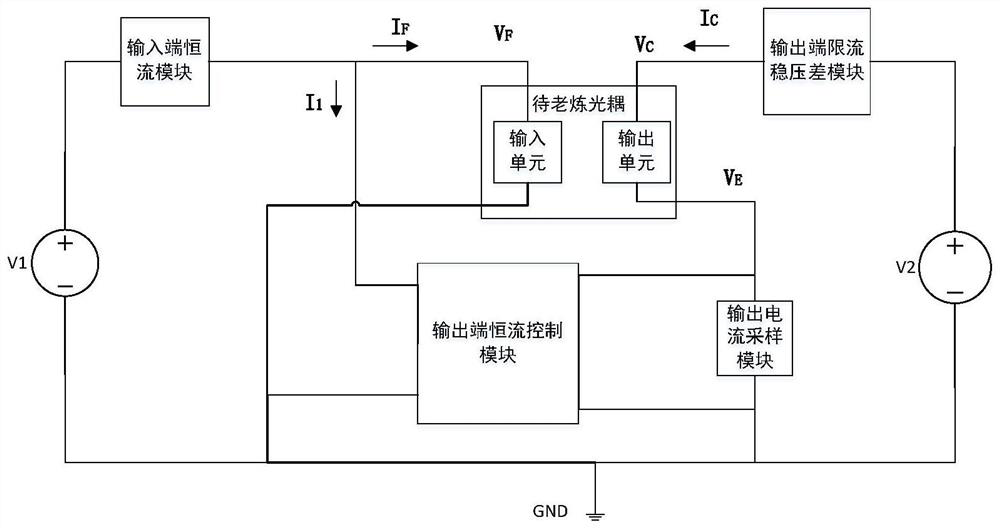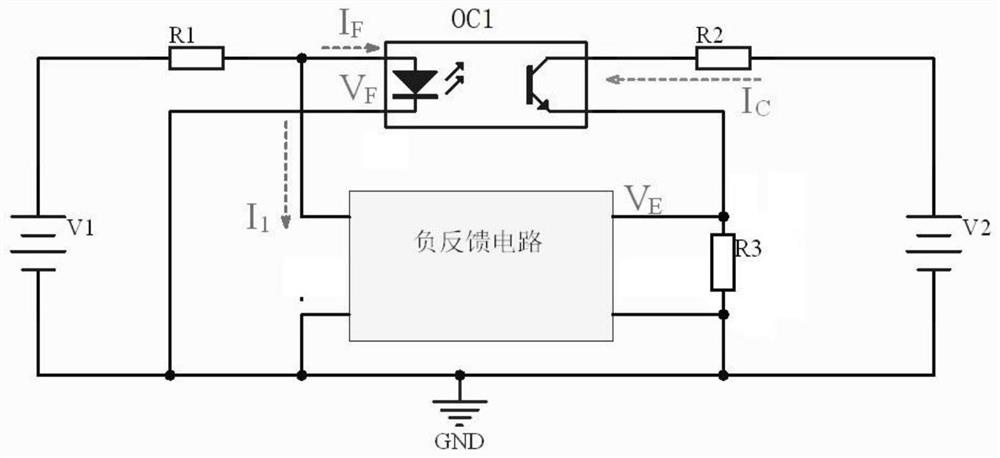Constant-power aging circuit for output end of photoelectric coupler
A photoelectric coupler and burn-in circuit technology, which is applied in the direction of instruments, measuring electricity, and adjusting electrical variables, etc., can solve the problems of unstable aging power of triodes, uncontrolled quality and reliability, and poor aging reliability, etc., to achieve The effect of large tolerance, good batch consistency and simple circuit
- Summary
- Abstract
- Description
- Claims
- Application Information
AI Technical Summary
Problems solved by technology
Method used
Image
Examples
Embodiment 1
[0061] Embodiment 1: ( Figure 5 )
[0062] The negative feedback circuit is realized by the common emitter circuit composed of NPN transistor Q2. The input end of the negative feedback circuit is the BE pole, and the output end of the negative feedback circuit is the CE pole. The NPN transistor Q2 is 2N3904.
Embodiment 2
[0063] Embodiment 2: ( Figure 6 )
[0064] The negative feedback circuit is realized by a compound transistor composed of PNP transistor Q1 and NPN transistor Q2. The base of Q1 is connected to the collector of Q2, the collector of Q1 is connected to the emitter of Q2 and grounded, the input terminal of the negative feedback circuit is the BE pole of Q2, and the output terminal of the negative feedback circuit is the CE pole of Q1. The PNP transistor Q1 is 2N3906, and the NPN transistor Q2 is 2N3904.
Embodiment 3
[0065] Embodiment 3: ( Figure 7 )
[0066] The negative feedback circuit is realized by the operational amplifier A1. The input terminal of the negative feedback circuit is the input terminal of A1, and the output terminal of the negative feedback circuit is the output terminal of A1. The operational amplifier A1 is a high-precision operational amplifier with high input impedance.
[0067] Such as Figure 5 A constant power burn-in circuit at the output of an optocoupler is shown:
[0068] Analysis of the principle of steady current and voltage regulation:
[0069] Taking Example 1 as an example, such as Figure 5 As shown, regardless of Q2 and R3, when V1 is powered on, a forward current I is provided to the light-emitting diode at the input end of the optocoupler. F , the light-emitting diode works, drives the phototransistor at the output end to conduct, and generates I C The relationship between current, IC and IF is determined by the CTR of the optocoupler:
[00...
PUM
 Login to View More
Login to View More Abstract
Description
Claims
Application Information
 Login to View More
Login to View More - R&D
- Intellectual Property
- Life Sciences
- Materials
- Tech Scout
- Unparalleled Data Quality
- Higher Quality Content
- 60% Fewer Hallucinations
Browse by: Latest US Patents, China's latest patents, Technical Efficacy Thesaurus, Application Domain, Technology Topic, Popular Technical Reports.
© 2025 PatSnap. All rights reserved.Legal|Privacy policy|Modern Slavery Act Transparency Statement|Sitemap|About US| Contact US: help@patsnap.com



